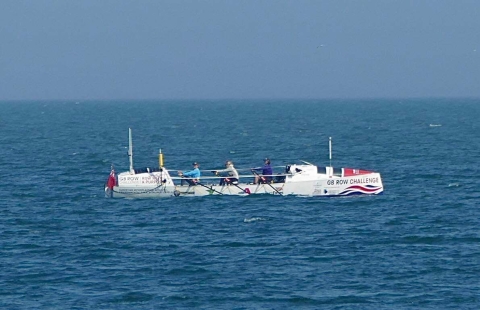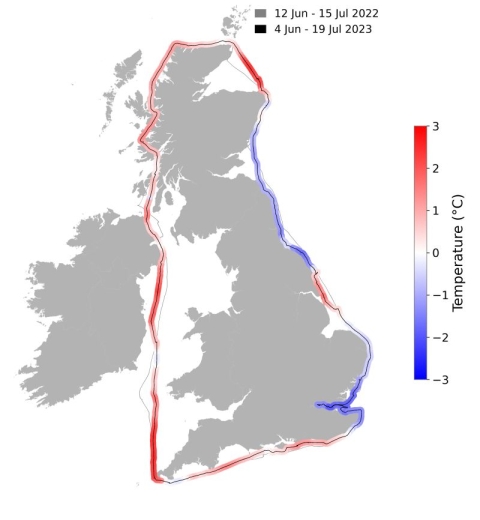

The data reveals UK coastal seas were on average 0.39C warmer in 2023 than in 2022
13 March 2024
6 min read
Sea surface temperature data collected by an all-female crew of rowers as they raced around Great Britain last summer has found that UK coastal seas were on average 0.39 degrees Celsius warmer in 2023, compared to 2022.
Some areas experienced even more substantial warming, with local increases exceeding two degrees Celsius in the Celtic and Irish Seas, and the northern North Sea.
The data fills geographical gaps in monitoring in areas not covered by oceanographic buoys, which means there is a comprehensive dataset for the whole of Great Britain’s coastline, thanks to the extraordinary efforts of the women in Team Ithaca who rowed two hours on and two hours off for 44 days.
GB Row Challenge is a 2,000-mile rowing challenge around Britain's rugged coastline, where teams brave treacherous waters to collect vital ocean data, which is then analysed by scientists at the University of Portsmouth.

Amy L Wood, Emma Haxell and Maggie Hodge rowing around Great Britain
Professor of Environmental Pollution and lead scientist, Fay Couceiro, said: “Our oceans play a crucial role in regulating the Earth’s climate by absorbing and storing large amounts of heat as well as driving weather patterns.
“This increase in temperature, however small, has far-reaching consequences for marine life, storm strength and rising sea levels.”
A temperature sensor was installed on the rudder of GB Row Challenge boats by ocean technology provider, RS Aqua.
Seawater temperature is usually monitored in UK coastal waters via a network of oceanography buoys carrying sensors, or are estimated from satellite data. The GB Row rudder sensor physically analysed seawater temperature every few minutes, building a ground truthed dataset spanning the entire UK coastline for 2022 and 2023.

This increase in temperature, however small, has far-reaching consequences for marine life, storm strength and rising sea levels.
Professor Fay Couceiro, Professor of Environmental Pollution and lead scientist
Laura Fantuzzi, a University of Portsmouth PhD student who worked on analysing the data, said: “Collecting temperature data year-on-year allows us to monitor ocean warming over time and is one of the ways that GB Row Challenge data is impactful.
“Given the great implications of a warming ocean to a country’s environmental, social and economic success, monitoring sea surface temperature is of utmost importance to anticipate where and how warming occurs.”
At sea, the sensor was at a depth of 75cm, similar to the sensors carried by the UK’s coastal monitoring buoys.
Laura added: “Satellites only measure the temperature at the very surface of the oceans, so it’s unclear how this intense heating penetrates the ocean interior, possibly affecting deeper ecosystems. The data collected by GB Row Challenge confirms that this heating reached at least 75 cm of depth.”

Temperature differences between 2022 and 2023 GB Row Challenges. Red indicates warming and blue cooling
A recent study on sea surface temperature trends, based on data from satellites and buoys, found that temperatures have been increasing by about 0.35 degrees Celsius every decade. But the GB Row Challenge data shows that in just one year, from 2022 to 2023, this level of warming was surpassed.
Professor Couceiro added: “This rapid warming is something we really need to pay attention to. The findings highlight the ongoing impact of climate change on marine environments, which has enormous implications for ecosystems, biodiversity and coastal communities.
“Understanding these trends is crucial for informing conservation efforts in the face of accelerating changes in environmental conditions.”
Alongside the warming in most of Great Britain’s coastal waters, a few locations experienced a decline in sea surface temperature from 2022 to 2023, such as in the Thames Estuary both at the start and end of the monitoring, and around Kent in early June. The latter area had the most intense cooling, with surface waters in 2023 up to 1.9 degrees Celsius cooler than in 2022.
Professor Couceiro and colleagues are also currently analysing data on microplastics, biodiversity, noise pollution and salinity from the 2023 race, to produce an ocean pollution and biodiversity map of Great Britain’s coastline.
The full report is available here: GB Row Challenge temperature data
You might also like...
Ocean rowers set new world record for fastest female team around Great Britain
A team of six ocean rowers has set a new Guinness World Record for the fastest female team to complete the GB Row Challenge.
19 July 2023
6 min read

Record-breaking rowers honoured at GB Row Challenge awards
Team Ithaca, the crew who set a new Guinness World Record for the fastest female team to row around Great Britain, received their medals and cup at an awards ceremony on Saturday.
15 November 2023
4 min read

National Survey finds microplastics pollution around Britain’s coastline up to 100 times worse than previously recorded
National Survey finds microplastics pollution around Britain’s coastline up to 100 times worse than previously recorded
27 March 2023
6 min read

